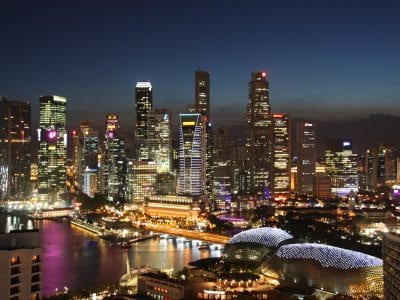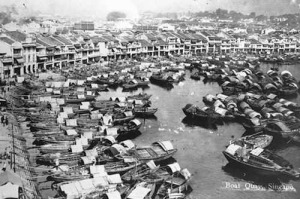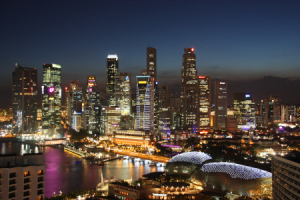
29 Oct History of Singapore
The Many Names of Singapore:
 The earliest accounts of Singapore were noted way back in the third century. Back then it was known as “Pu-luo-chung”, or rather “The Island at the End of the Peninsula” (A+ for creativity). But as settlers started creating a community on the small island, Singapore became known as Temasek (“Sea Town”) until the 14th century. Legend says that Prince Sang Nila Utama, a ruler from Palembang, was on a hunting trip in Singapore when he saw a lion-esque creature roaming around. Intrigued by this never before seen animal, he went to where he spotted it, and created a city: Singapura, which means “The Lion City.” The term Singapura is broken down into ‘simha’-sanskrit for lion, and ‘pura’-city.
The earliest accounts of Singapore were noted way back in the third century. Back then it was known as “Pu-luo-chung”, or rather “The Island at the End of the Peninsula” (A+ for creativity). But as settlers started creating a community on the small island, Singapore became known as Temasek (“Sea Town”) until the 14th century. Legend says that Prince Sang Nila Utama, a ruler from Palembang, was on a hunting trip in Singapore when he saw a lion-esque creature roaming around. Intrigued by this never before seen animal, he went to where he spotted it, and created a city: Singapura, which means “The Lion City.” The term Singapura is broken down into ‘simha’-sanskrit for lion, and ‘pura’-city.
Since then, the city has flourished under the rule of the succession of kings of Singapura. Because of its strategic location, Singapore also grew as a trading post, attracting Chinese, Arab, Portuguese, Thai, Malay, Javanese, and Indian traders.
Singapore on the Rise:
Singapore’s attractiveness as a potential asset did not go unnoticed. Britain, in particular, had set its sights on this up-and-coming trading post, and had plans to make Singapore a base for its merchant fleet. Colonizing Singapore also meant strategically placing the Dutch at a disadvantage. And thus, the British sent Sir Thomas Stamford Raffles.
Raffles was a Lieutenant-Governor of Bencoolen in Sumatra and was an agent of the British East India Company. It was with his arrival in the 19th century that modern Singapore began to develop. He saw the immediate potential of Singapore and with a little negation with Singapore’s local rulers, he transformed Singapore into a major trading station. Since then it grew and attracted immigrants from around Asia, and eventually, the world.
However, with so much chaos stemming from the influx of immigrants, Raffles had to enact the Jackson Plan to separate ethnic residential areas into four sectors: European Town, where European traders, Eurasians and rich Asians lived, and Chinatown, where (not surprisingly) the ethnic Chinese lived. Ethnic Indians typically lived north of Chinatown and in Kampong Glam, a neighborhood north of the Singapore River, there lived Muslims, Malays, and Arabs.
1900s: World Wars and Singapore’s Road to Independence
Even though Singapore went relatively unscathed by the First World War, it did not have as much luck in the second. It’s continuing prosperity came to a sudden halt when the Japanese attacked from the north. Of course Britain tried to protect one of its most valuable colonies, but they thought the fight would have come from the south, which is where they stationed their troops. Because of this defeat, the Allied forces had to surrender Singapore to the Japanese in 1942, and again, Singapore’s name changed; it’s new name- Syonan-to (Japanese for “Light of the South”). The Second World War had really taken a toll on Singapore as crime and corruption ran amok, the death rate skyrocketed, and the infrastructure of the city was severely damaged.
But with the passage of time, the Allied forces defeated the Japanese in 1945, and the island was given back to the British Military Administration. After having been through all the destruction and back, the citizens of Singapore realized the downfalls of being under colonial rule, and lobbied for independence. The next year, Singapore became a British Crown Colony with its own civil administration.
From then on, nationalism started to grow, and eventually led to Singapore’s own self-government. The People’s Action Party (otherwise known as the PAP) was led by Lee Kuan Yew, and under his leadership, he became the first prime minister of Singapore.
Modern Singapore
Soon after making steps toward full independence, the Federation of Malaysia was formed, which was essentially supposed to be an alliance between Malaya, Singapore, Sarawak, and North Borneo (presently Sabah). Although it was supposed to tie the countries together, Singapore opted out to pursue further independence from Britain. Since then, it has worked to incredible lengths to create itself into what it is today. Being a small island with very few resources, Singapore’s citizens have dedicated themselves to bringing Singapore to the top.
After getting itself into a position of power, Singapore joined with Brunei, Indonesia, Malaysia, the Philippines, and Thailand to form the Association of Southeast Asian Nations (ASEAN), which would help promote regional stability, economic development, and cultural exchange.
Since then, Singapore has sustained its economic growth to the point where it is now considered one of the ‘Four Tigers’ of Asian economic prosperity alongside Hong Kong, South Korea, and Taiwan.
Today, there are several monuments, museums, and memorials to commemorate Singapore’s history, so when you have time off from your internship in Singapore, it wouldn’t hurt to take a look!


No Comments